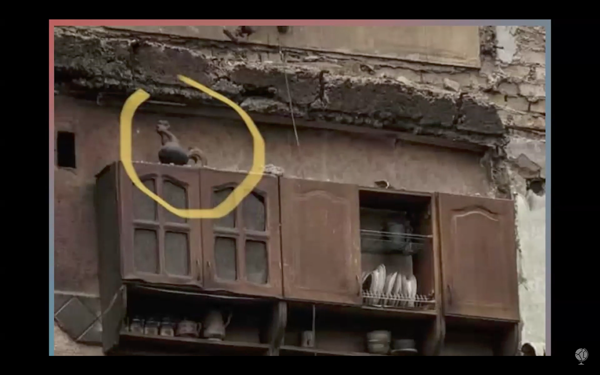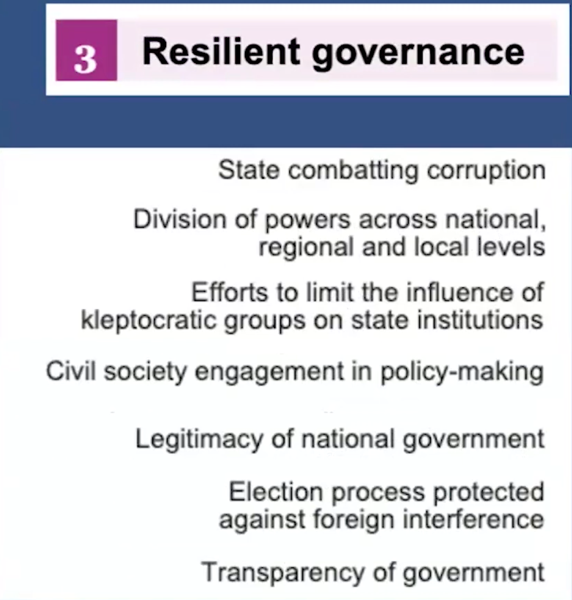using a rooster.
Chatham House vor vier Stunden.

Orysia Lutsevych: I just wanted to uh to to start with this of course image that many of you may know, recognize um some of you don’t but you know where is resilience on on this picture and it really is right here um in the um um trying to uh um uh it’s right here uh this little rooster from um Ukrainian ceramic Factory near Kiew that survived the bombardment of building in banka uh that became by the choice of ukrainians themselves a symbol of resilience and when Natalie you were asking me how do we define resilience what is it if you look at this rooster you may say it’s actually surviving a violent shock is to be able to stand in um a times of um assault on your uh very existence right uh but it is also capacity to prepare for the future disruption right, it’s something that Society should be thinking about and actually recover from shock recover from shock possibly even stronger and that is I would say the highest level of resilience of any society or an individual than before it’s learning from this um violent experience to fortify uh for your systems uh your response to Future adversity and um that is why you know we we were trying to think whether there could be a comprehensive system that could capture what it is that we want to see in the society that is resilient and and of course like you like you said perhaps Ukraine became even like this victim of resilience where a lot of people you know lean back on this hoping that this will help carry out Ukraine throughout the war and um our task in Chatham House, when we look at this concept was to try to suggest some pillars where if we look at the society as a whole and it’s not just as individual how we could look at some of the qualities uh that would tell us how how strong or weak um a certain community is and these are the five pillars we’re looking from human security to cognitive resilience and each of those pillars has seven indicators so overall - there are 35 indicators, we did not test this methodology on Ukraine I would like to make it very clear this was tested in Moldova um it was designed uh to be under the threshold of full scale kinetic War it’s a society that feels pressure from outside to undermine its um its um course and it’s for those sharp powers of malign influence who want to especially in our region is Russia so uh we’ve surveyed um experts independent experts non-government experts about how they see this in Moldova and this is just to illustrate the outcome of this uh based on this survey where you could see in Moldova people feel that human security remains quite vulnerable - weak whereas economic agility remains quite, you know is is more solid so how can we use this and I do believe that when we are looking at Ukraine right now the country at War we can um to a degree um apply this framework and these indicators under each of those criteria so I will just literally briefly say if we’re looking at human security what really helped Ukraine from my understanding is said some communities were prepared they had tabletop exercises not all of them and actually covid cooperation around pandemic helped develop some of these networks I will not go one by one I’ll just mention some of them that I think something to keep in mind for the future if we look at Social cohesion this remains one of the big concerns at the moment with the war and its impact on people um and um for example the way in which um protection of rights of vulnerable minorities of of people impacted by War from veterans to Children uh and the conflicts between those who are fighting who are not fighting who are abroad who are in Ukraine is something that you know risks undermining Ukrainian resilience but overall the the purpose of the mission in Ukraine remains very strong if we look at the governance what we hear and see from uh Ukraine is there’s the real concern about combating corruption it remains an issue where people feel that actually 63% of ukrainians believe it’s a priority because it’s one of those um areas that is wasting resources and also builds a a feeling of Injustice uh in Ukraine so you know if if if we look underneath the governance it’s one of those areas where Ukraine needs much more effort but of course on the upside we look at the transparency of governance governance we’re looking about digitalization of services here Ukraine is a Pioneer and actually being able to deliver a lot of services online in an open way um helped ukrainians in crisis on the go to be able to access services and that that contributes to Ukrainian resilience.
Wait what?!
Beware the rooster?!





Thank you Orysia Lutsevych, deputy director of the Russia and Eurasia Programme and head of the Ukraine Forum at Chatham House.
Of course Orysia Lutsevych is not only a valuable member of the Ukraine Forum at Chatham House, she is also the most valuable connection for feeding ukrainian propaganda straight into the DGAP (Deutsche Gesellschaft für Auswärtige Politik)
Den üblichen Sager “Propaganda hat wieder niemand entdeckt, kann ich diesmal nicht bringen, denn die Aufgabenstellung bei Chatham House war es ja Durchhaltepropaganda zu brainstormen.
Dass dabei nur gequirlte Scheisse rauskommt, liegt an den beteiligten Personen.
Die aber sonst noch passgenau die Deutsche Gesellschaft für Auswärtige Politik briefen.
Einen Conflict of Interest hat natürlich noch niemand entdeckt.
Wir halten fest: Bei Chatham House wird jetzt bereits Durchhalte Propaganda und dafür nutzbare Symbolik für die Ukraine gebrainstormt, nur die deutschen Medien hätten immer noch keine Propaganda entdeckt.
Dass die ukrainische Propagandistin die auch für die Ukraine/DGAP Kommunikation abgestellt ist damit komplett überfordert scheint, ehrt sie beinahe schon.

